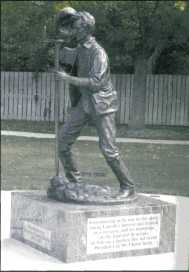 |
Home | Search | Browse | About IPO | Staff | Links |
 |
Home | Search | Browse | About IPO | Staff | Links |
|
Humble beginnings For the first time in 35 years, a new statue of Abraham Lincoln was unveiled at Lincoln's New Salem State Historic Site in Petersburg. The statue, "Abraham Lincoln: Deputy County Surveyor," was commissioned by the Illinois Professional Land Surveyors Association and shows a 25-year-old Lincoln peering through a surveyor's compass. Lincoln arrived in New Salem in 1831 at the age of 22 and lived there until 1837. The county surveyor asked Lincoln to become a deputy county surveyor, even though Lincoln knew nothing about the work. He kept this position from 1833 to 1837. It is not known if Lincoln surveyed lots in New Salem, but he surveyed lots in nearby Petersburg. His original surveying equipment is on display at the Lincoln's New Salem Visitor Center. The statue, unveiled on October 4, is located at the entrance to the New Salem village between the Visitor Center and souvenir shop. "The Illinois Professional Land Surveyors Association wanted to sponsor a statue of Lincoln to commemorate his work as a surveyor," said Bob Church, executive director of the Association. "We feel surveying was an important part of his early life, and helped his development as a statesman. Lincoln campaigned unsuccessfully from New Salem for the state legislature in 1832. He became a surveyor in 1833 and got to know the area settlers. In 1834, he was elected to the Illinois House of Representatives. The statue was created by Decatur sculptor John McClarey. He has created Lincoln works for several Illinois cities and is currently working on a Lincoln statue for the Abraham Lincoln Presidential Library and Museum.  Photo courtesy Bob Church 4 Illinois Heritage  Charlie was no angel More than 75 years after his death, clapper Prohibition-era gangster Charlie Birger is remembered as a common criminal to some and as a folk hero to others. But a new, two-hour video documentary produced by WSIU-TV and WUSI-TV in Carbondale, hopes to set the record straight about the "Robin Hood of Little Egypt." The Legend of Charlie Birger premiered last month in southern Illinois and is the most ambitious local project ever undertaken by Southern Illinois University-Carbondales public television station. Producers David Kidd and Grant Morrow worked diligently to separate historical fact from popular fiction in telling the Birger story. "Birger continues to fascinate people," said Kidd, "but the fact remains that he was a cold blooded killer." First-person narratives, old photographs, and newspaper clippings supplement on-camera commentary by Gary DeNeal, author of A Knight of Another Sort: Prohibition Days and Charlie Birger; John Y. Simon, director of the Ulysses S. Grant Association at SIUC's Morris Library; Taylor Pensoneau, author of Brothers Notorious: The Sheltons, Southern Illinois' Legendary Gangsters; and southern Illinois historian Gordon Pruett. The documentary includes reenactments of key crimes committed by Birger and his gang, which culminated in Birger's public execution on April 19, 1928, in Benton. (The grim ballad "The Hanging of Charlie Birger" appeared in Illinois Heritage, Vol. 5, #2). For more information about screenings of the documentary, call 618-453-5060. Professional development Jason Meyers, winner of the Illinois State Historical Society's 2003 Malkovich Award for Young Museum Professionals, will use his scholarship to attend the Association of Midwest Museums and the Wisconsin Federation of Museums 2003 Joint Annual Conference this November in Milwaukee. Meyers will attend sessions on how to develop permanent and traveling exhibits geared for the small museum. He'll also attend a workshop titled, "Meaning-Making Through Design," which offers strategies for enhancing exhibits through graphics. The Malkovich Award, named for southern Illinois historian Dan Malkovich, is awarded annually to a full-time museum professional under the age of 30 who has shown leadership and creativity in the field. (For more information on the Malkovich Award, see page 20 in this issue.) Iroquois inferno remembered The "worst single building fire in United States History" is grippingly recounted in the Fall 2003 issue of Chicago History magazine. The Iroquois Theatre inferno of December 30, 1903, took the lives of more the 600 Chicagoans, most of them women and children who'd taken advantage of their Christmas holiday to watch a matinee performance of Mr. Blue Beard. Billed as an "absolutely fireproof building, the Iroquois had been open less than six weeks when sparks from a faulty spotlight ignited the stage curtain, sending billows of smoke and noxious gas through the theatre. In less than 30 minutes, hundreds were asphyxiated, burned, or trampled to death. For more information on the tragedy and how it changed safety standards in public buildings, visit www.chicagohistory.org. "Education and Justice" focus of annual Symposium The Society's 24th annual Illinois History Symposium will be held December 5 and 6 in Springfield at the Crovvne Plaza Hotel. Sessions topics include Abolition and the Underground Railroad; Remembering the 1970 Constitutional Convention; Lincoln and Douglas in Love and Pictures; Chicago Celebrates a Century Since Kitty Hawk; Women in the Civil War, among others. Continuing Professional Development Units (CPDUs) will be available for elementary, middle, and high school teachers who attend the symposium. Illinois Heritage | 5 |
|
|